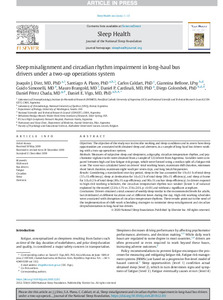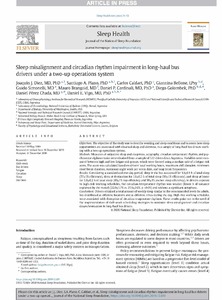Por favor, use este identificador para citar o enlazar este ítem:
https://repositorio.uca.edu.ar/handle/123456789/10054| Título: | Sleep misalignment and circadian rhythm impairment in long-haul bus drivers under a two-up operations system | Autor: | Diez, Joaquín J. Plano, Santiago Andrés Caldar, Carlos Bellone, Giannina J. Simonelli, Guido Brangold, Mauro Cardinali, Daniel Pedro Golombek, Diego A. Pérez Chada, Daniel Vigo, Daniel Eduardo |
Palabras clave: | CONDUCTORES DE AUTOBUSES; FATIGA; RITMO CIRCADIANO; CRONOBIOLOGIA; SUEÑO; SALUD LABORAL | Fecha de publicación: | 2019 | Editorial: | Elsevier | Cita: | Diez, Joaquín J., et al. Sleep misalignment and circadian rhythm impairment in long-haul bus drivers under a two-up operations system [en línea]. Postprint de artículo publicado en Sleep Health. 2019. doi: 10.1016/j.sleh.2019.12.011. Disponible en: https://repositorio.uca.edu.ar/handle/123456789/10054 | Resumen: | Abstract: Objectives: The objective of the studywas to describeworking and sleep conditions and to assess howsleep opportunities are associated with obtained sleep and alertness, in a sample of long-haul bus drivers working with a two-up operations system. Methods: Measures of subjective sleep and sleepiness, actigraphy, circadian temperature rhythm, and psychomotor vigilance tasks were obtained from a sample of 122 drivers fromArgentina. Variables were compared between high and low fatigue risk groups, which were formed using a median split of a fatigue risk score. The score was calculated based on drivers' total working hours, maximum shift duration, minimum short break duration, maximum night work per seven days, and long break frequencies. Results: Considering a standardized one-day period, sleep in the bus accounted for 1.9±0.1 h of total sleep (57±1% efficiency), sleep at destination for 1.6±0.2 h of total sleep (90±1% efficiency), and sleep at home for 3.8±0.2 h of total sleep (89±1% nap efficiency and 90±1% anchor sleep efficiency). In drivers exposed to high-risk working schedules, the circadian temperature rhythm was weaker (lower % of variance explained by the model) (22.0±1.7% vs. 27.6±2.0%, p <0.05) and without a significant acrophase. Conclusions: Drivers obtained a total amount of weekly sleep similar to the recommended levels for adults, but distributed at different locations and at different times during the day. High-risk working schedules were associated with disruption of circadian temperature rhythms. These results point out to the need of the implementation of shift-work scheduling strategies to minimize sleep misalignment and circadian desynchronization in long-haul bus drivers. | URI: | https://repositorio.uca.edu.ar/handle/123456789/10054 | ISSN: | 2352-7218 | Disciplina: | MEDICINA | DOI: | 10.1016/j.sleh.2019.12.011 | Derechos: | Acceso abierto. 12 meses de embargo | Fuente: | Sleep Health. 2019 |
| Aparece en las colecciones: | Artículos |
Ficheros en este ítem:
| Fichero | Descripción | Tamaño | Formato | |
|---|---|---|---|---|
| sleep-misalingment-circadian-rhythm.pdf | 1,45 MB | Adobe PDF |  Visualizar/Abrir | |
| sleep-misalingment-circadian-rhythm.jpg | 908,29 kB | JPEG |  Visualizar/Abrir |
Visualizaciones de página(s)
139
comprobado en 27-abr-2024
Descarga(s)
234
comprobado en 27-abr-2024
Google ScholarTM
Ver en Google Scholar
Altmetric
Altmetric
Este ítem está sujeto a una Licencia Creative Commons

